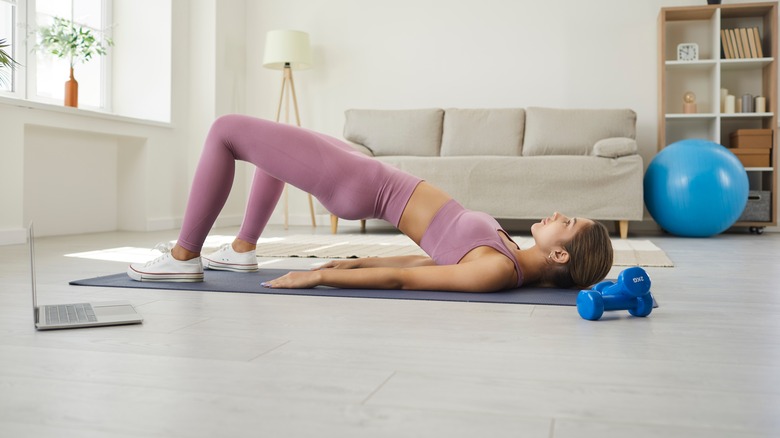Easy Exercises That Will Help Ease Your Constipation
When was the last time you had a bowel movement? Admittedly that's a provocative question. However, how often you empty your bowels might say a lot about your intestinal health. According to the Cleveland Clinic, you might have constipation if you have fewer than three bowel movements a week. Also, when you have constipation, pushing stool out of your body is strenuous, since your colon absorbs too much water from your waste.
Constipation affects about 4 million adults in the United States (via Johns Hopkins Medicine). However, the National Insitute of Diabetes and Digestive and Kidney Diseases (NIDDK) describes it as a symptom, not a disease. A variety of causes of constipation include lack of exercise, not drinking enough water, and not eating enough fiber. Other more serious causes include diabetes and hypothyroidism (via NIDDK).
Although the cause of your constipation will determine the treatment, being more physically active might help increase muscle activity in your intestines, easing bowel movements, per Mayo Clinic. Before taking up any physical activity, be sure to speak to your doctor, who can help you develop a routine that fits your energy levels. As a guide, we've listed below various exercises to help ease constipation.
Kegel exercises
Kegel exercises, also known as pelvic floor muscle training exercises, can help strengthen the muscles of your pelvic floor, per Cleveland Clinic. They're often included as part of a bowel retraining program to help strengthen rectal muscles, ensuring easy bowel movement (via Medline Plus). According to a 2022 study published in the journal StatPearls, kegel exercises have been a mainstay in managing pelvic floor weaknesses since 1948. Physiotherapists can tailor the routines to users' needs making them easier to implement.
Even though there are no specific protocols to get the kegel right, it's crucial to stick to the basic rules, like knowing which muscles the exercises work on, as per Harvard Health Publishing. Unfortunately, many people don't get the routines right. In fact, as many as one-third don't reap the benefits of kegel exercises. Rather, they end up working their abdominal, buttock, or other thigh muscles.
To get it right, Healthline suggests beginning with a comfortable sitting pose with your knees wide apart. Once in this position, squeeze the muscles in your anus tightly, as if you're trying to prevent gas passing. Hold this position for five seconds, release, count to 10, and repeat the entire process five times in a row. You can hike the intensity as you go on, squeezing and releasing the muscles as often as possible.
Cardio
Cardiovascular (or cardio) exercises are physical or rhythmic activities that can increase your heart rate, according to Medical News Today. The American Heart Association recommends at least 150 minutes of moderate-intensity or 75 minutes of high-intensity aerobic exercises every week. Running and swimming are good examples of cardio or aerobic exercises that help maintain the health of your digestive tract, according to WebMD.
Medline Plus also recommends walking and swimming at least three to four times weekly to keep the digestive tract healthy. When running, your breathing and heart increase, which helps contract your intestinal muscles, ultimately pushing stools out faster, per WebMD. According to a 2006 study published in the Physical Therapy and Rehabilitation Journal, moderate aerobic exercises can increase gut transit. At the same time, experts found that intense exercises, such as strength training, improved whole bowel transit time in middle-aged individuals, who previously led sedentary lifestyles.
Yoga
The United Nations Educational, Scientific and Cultural Organization (UNESCO) defines yoga practice as a mental, physical and spiritual exercise. In fact, the number of Americans practicing yoga increased by 50%, from 20.4 million in 2012 to over 36 million as of 2016, per Harvard Health Publishing. Yoga massages your digestive organs and increases blood flow and oxygen delivery, which can encourage stools to move through your intestines easily (via Healthline).
Medical News Today lists various yoga poses that help relieves constipation. The first is the supine spinal twist pose, which involves bending one leg at the knee while lying and keeping the shoulders flat. If you're a beginner, the wind-relieving pose, which requires you to tuck the chin and gently press the back into the floor while lying, can be a great alternative. Then there's the bow pose, which involves lying flat on your stomach, gently raising your chest off the floor, and lifting your thighs and upper body with your arms reaching back. This pose can significantly strengthen abdominal muscles.
If you don't have a yoga mat, you might prefer to stand when trying this next pose known as the crescent lunge twist. It begins with you standing before transitioning into the lunge position. Then simply twist your torso, a movement that can help promote a bowel movement.
Deep breathing
Adding breathing exercises to a constipation relief routine comes with many benefits. They can help calm and massage your system, which significantly improves your chance of having a seamless bowel movement, as stated by Michigan Medicine.
Diaphragmatic breathing, for example, can come in handy. Although it's usually prescribed to people with gastrointestinal (GI) problems, it can also be used when sitting in the toilet to calm your system and relieve constipation. You'll first need to place one hand on your chest and the other on your abdomen. Inhale through your nose for about four seconds, and don't stop until you feel your abdomen expanding. After, you can exhale slowly through your mouth for about six seconds. Doing that repetitively can help ease your constipation.
The 4-7-8 breathing technique is also another way to practice deep breathing and can relieve stress, explains Healthline. The method is especially beneficial to those that get constipated as a result of high stress.
What's the best time to exercise?
There are various divided opinions on what the best time to exercise is. Ultimately, it depends on your fitness objectives and the time available on your hands. It would be best to consult with your doctor before starting any vigorous exercise routine. A 2019 research paper advises exercising as early as 7 a.m. or between 1 p.m. and 4 p.m. to regulate your body's circadian rhythms, helping you fall asleep and wake up easily. However, don't follow this timing religiously so you can prevent the inconsistency that arises with trying to keep up. Given this, you don't have to overwork yourself. High-intensity exercises might cause muscle strains and fractures, especially if you go beyond your capabilities.
Making a note of the duration between meals is another best practice when exercising, explains Healthline. It's best to wait an hour or two after meals before kickstarting your routines. That gives your body enough time to digest the food.






